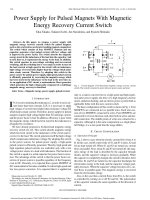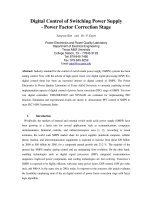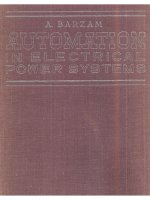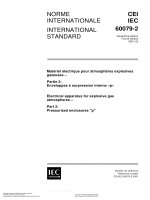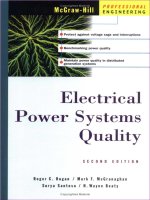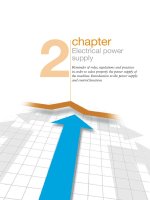asg 2 electrical power supply
Bạn đang xem bản rút gọn của tài liệu. Xem và tải ngay bản đầy đủ của tài liệu tại đây (644.98 KB, 8 trang )
2
2
chapter
Electrical power
supply
Reminder of rules, regulations and practices
in order to select properly the power supply of
the machine. Introduction to the power supply
and control functions
Summary2. Electrical power
supply
3
1
2
3
4
5
6
7
8
9
10
11
12
M
2.1 Introduction Page
2.2 Power supply to machinery Page
2.3 Standards and conventions Page
2.4 Power supply functions Page
2.5 Power supply to the control circuit Page
2.1 Introduction
2.2 Power supply to machinery
2.3 Standards and conventions
2. Electrical power
supply
4
2.1 Introduction
This section explains how electrical systems in machinery are supplied
with electricity. A supply system acts as an interface between the mains
installation and the machinery and must meet the technical standards and
constraints of both
(C Fig
.1)
. It is the latter which is described her
e and
readers are advised to refer to the
Electrical installation guide for further
information.
2.2 Power supply to machinery
As illustrated in the diagram (C Fig. 2), an electrical power supply is
divided into two units.
The power unit feeds machine loads such as motors or heating circuits
via the control components (pre-actuators). Voltage usually ranges from
200V to 660V in 3-phase and 120V to 230V in single phase.
The contr
ol unit powers automation components such as contactor coils,
solenoid valves, PLCs, sensors, etc. Voltage is usually low (120V to 200V
in single phase) and extra low (12 to 48V).
This unit is often called the “head” and governs a set of functions described
in subsection 2.4.
2.3 Standards and conventions
As we have already said, an electrical power supply is governed by constraints
in two areas:
b Electrical distribution system
Each country has its own conventions and defines its own rules. This
means ther
e are a great many different standards, such as C15-100 in
France. We can however summarise the constraints and conventions
regarding equipment powering devices as follows:
- mains voltage. A table of voltages per country is provided in the
Electrical installation guide and the characteristics of public
distribution networks are given in EN 50160:1999,
- neutral distribution and system earthing,
- wiring practices,
- product standards and clearance distances,
- types of fuses for fuse-holders or fused switches.
A Fig. 2 Power supply functions
A Fig. 1 Electrical power supply architecture
2.3 Standards and conventions
2. Electrical power
supply
5
b Machinery
Standards have been brought in line with IEC 60 204-1 to facilitate export
and use the same machines through the world. Few countries have
retained some specific rules; elements of the main ones are given in the
table in
(C Fig. 3) below.
TNC diagrams are not permitted in low-voltage installations in buildings (Norway).
TT power diagrams are not permitted (USA).
The neutral conductor break is mandatory in TN-S diagrams (France and
Norway).
The distribution of a neutral conductor in an IT diagram is not permitted (USA and
Norway).
The maximum rated voltage of an AC control circuit is 120V (USA).
The minimum gauge of copper conductors is specified in ANSI/NFP
A 79 in
American sizes (AWG) (USA). Annex G of the standard gives the equivalent in
mm
2
of the AWG.
WHITE or GREY is used to identify neutral earthed conductors instead of BLUE
(USA and Canada).
Marking requirements for rating plates (USA).
b Three zones of influence
Notwithstanding the differences in standards and practicies amongst
countries, there are three major zones of influence: Europe, USA and
Japan
(C Fig. 4).
2
A Fig. 3 Specific features of standards and practices in a number of countries
A Fig. 4 Requirements in the zones of influence
Japan
200V
JIS C 0364
JIS-B 9960
JIS-C 8201-2-1
JIS-C 8269
JIS-C 8201-4-1
Lug clamps
Wires with lug
clamps
Electrical
distribution
Machine
powering
equipment
standards
Head device
T
ype of
upstr
eam
connection
Zone of
influence
3-phase supply
voltage
L
V installation
rules / standar
ds
See differences
above
Circuit breaker
Switch / fuses
Motor
contactors /
circuit
breakers
<100A
>100A
USA
480V
NEC
IEC60204-1
UL 489
UL98
UL508
>100A
connectors
Parallel wires
Europe
400V
IEC 60364
IEC60204-1
IEC60947
IEC 60269
Dif
ferent fuses
per country
IEC 60947
Connectors,
scr
ew
brackets,
elastic
connections
Wires with lugs
or busbars
2.4 Power supply functions
2. Electrical power
supply
6
2.4 Power supply functions
There are three separate functions:
b Supply and cut off the machine power and control units
with attention to the following points
v Break capacity
Depending on the power installed, the pr
ospective short-circuit current in
the event of an incident can range from a few kA to several hundred kA,
so the device must be sized accordingly.
v Short-circuit endurance
A short-circuit downstream of the electrical equipment must not cause
destruction of the device.
v Connection capacity
Internal wires in equipment are always in copper but it should be noted
that aluminium is used in electrical system distribution. The input device
should therefore withstand both types of connection.
v Manual control and remote control on cabinet
Safety rules require direct control from the electrical cabinet to switch off
or disconnect the installation.
b Personal protection
Electrical cabinets are usually locked during operation, so operators do
not have access to them. Regulations stipulate personal protection rules
for working inside of electrical devices, in particular for starting and
maintenance. Personal protection requires compliance with a number of
rules:
- IP20 protection against contact with internal connections,
- disconnection.
This function ensures the installation is completely or partly disconnected
from any source of electrical power for safety reasons.
• Insulation
Insulation must be ensur
ed when a contr
ol device is open, i.e. the leakage
current must be below the danger threshold.
• Padlocking
This function is intended to prevent any unauthorised person from
switching on electrical devices.
• Contr
ol insulation
This must be adequate to pr
otect people and electrical equipment from
over-voltage and other electrical pollution.
• Equipotential connection
Installation rules can stipulate earthing or insulation according to the system
eathing used.
b Distribution network protection
Protection from incidents due to the machine must include break capacity
and coordination and discrimination. An incident should never have
adverse effects on the rest of the distribution system.
2.4 Power supply functions
2.5 Power supply to the control circuit
2. Electrical power
supply
7
b Power unit supply
The table (C Fig. 5) summarises the power units and functions covering
the requisite functions.
2.5 Power supply to the control circuit
The power supply to the control circuit is governed by regulatory and
technological constraints. The need for personal protection has led to the
use of extra low voltages (ELV), i.e. less than 50V. Electronic components
are now widespread and require direct current to power them.
Apart from simple or specific applications which still use low voltage,
DC ELV power supplies are now commonly used.
b 24V power supplies
Her
e we describe dif
ferent types of 24V sources. This voltage is now
standard in industry and most manufacturers have extensive product
ranges. Standardisation helps to limit the risk of incompatibility between
products.
•
This solution has a number of benefits
- saving in space and equipment,
- improved reliability and circuit-break detection available on some
PLCs,
- personal safety
,
- operating continuity ensured by backup systems or voltage drop
filters,
- no capacitive effect in wiring,
- envir
onmental pr
otection due to lower electricity consumption.
•
But ther
e ar
e also some drawbacks
- low voltage limits cable length,
- the number of contacts in series or sensors is limited,
- caution must be taken with earth links,
- contacts can deteriorate quickly in hostile environments (dust,
chemicals, etc.),
-
ther
e may be pr
oblems of compatibility between PLC output
specifications and contactor sensors and coils. It is advised to use
low-consumption contactors which are well suited to this kind of use.
2
Function Fuse Dimmer INS Fused Magnetic line Differential
holder switch switch circuit-breaker circuit-breaker relay
Disconnection XX XX XX XX XX XX
Switch-off X XX XX XX XX
Short-circuits protection XX XX X XX
Isulation XX XX XX XX XX XX
Short-circuits immunity X X XX XX X XX
Padlocking XX XX XX XX X XX
Protection from
option XX
earth faults
A Fig. 5 Comparative device table
2.5 Power supply to the control circuit
2. Electrical power
supply
8
b 24V dir
ect current technologies
Technologies have also progressed in this area. Conventional power
supplies use a transformer with separate windings which convert the
voltage and insulate LV from ELV. Improvements in switching technology
along with lower costs make this an advantageous alternative in several
ways. A description of both technologies follows.
v Rectified power supplies
These consist of an LV/ELV transformer followed by a bridge rectifier and
a filter
(C Fig. 6).
Upstream power to the transformer can be single or 3-phase; the latter
(C Fig. 7) dispenses with the need for smoothing capacitors. Though this
solution is more reliable, its immunity to micro-breaks is lessened.
A Fig. 6 Working diagram of a 24V power supply
A Fig
.
7
Single-phase and 3-phase r
ectification
2.5 Power supply to the control circuit
2. Electrical power
supply
9
v Switching power supplies (C Fig
.8)
The working principle involves switching the voltage from a rectified source
to a high frequency of a few dozen to several hundred kHz. This makes
possible to power a ferrite transformer with a better power weight ratio than
conventional 50Hz transformers. The output is then rectified and filtered.
A loop feedback controls the high-frequency switch cycle time to ensure
the requisite regulation characteristic (C Fig. 9).
v Conclusion
The table (C Fig
. 10)
gives a brief comparison of the two technologies.
For mor
e details, see the section on pr
oduct implementation.
2
Comparison for a
10A/24V DC source
Input voltage range
Overall dimensions
W
eight
Efficiency
Output voltage
adjustment
Microbreak immunity
Load regulation
Line regulation
EMC pollution
Harmonic pollution
Reliability
, lifetime
Regulated switched power
Wide range of 85 to 264V
3dm
2
1.5kg
Up to 85%
Y
es
High >20ms
1 to 3%
<1%
Requires careful design
As per EN61000-3-2 with
filter
Good
Rectified filtered power
Set ranges of 110V to 230V
7dm
2
6kg
Up to 75%
No
Low <5ms
5%
5-10% depending on mains
Naturally low
Basically as per standard
EN61000-3-2
V
ery good
A Fig. 10 Comparison of direct current power supplies
A Fig. 8 Switched power supply
A Fig. 9 Principle of switched power supplies
